Answer these simple questions and we will find you the BEST prices
Which type of solar quotes do you need?
It only takes 30 seconds
100% free with no obligation

Get Free quotes from insulation specialists near you

Save money by comparing quotes and choosing the most competitive offer

The service is 100% free and with no obligation
- GreenMatch
- Insulation
- Breathable Insulation
Your Guide to Breathable Insulation in UK
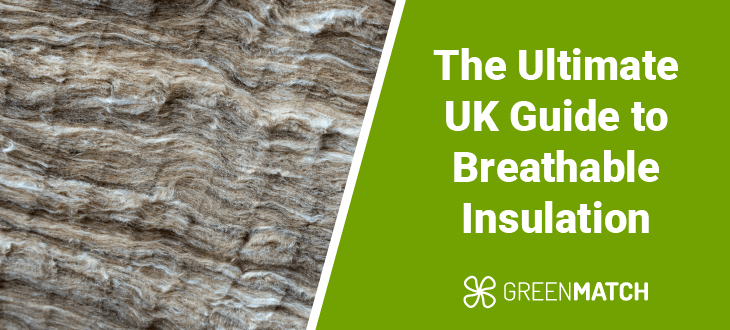
- Breathable insulation materials allow for moisture vapour through their porous nature, reducing the risk of condensation buildup.
- The most popular breathable insulation materials on the market are blanket-style insulators like mineral wool, sheep wool, and fibreglass insulation.
- Your common fibreglass and mineral wool sheets can cost around £10 - £17.5 per m2.
Home insulation is one of the smartest upgrades anyone can carry out, reducing your heating systems' need to work overtime just to compensate for lost heat. This helps you enjoy sky-high savings on your energy bills, a reduced domestic carbon footprint, and a comfortable temperature-regulated home.
A problem insulated homes may sometimes run into is condensation buildup, usually as a result of poor ventilation and lack of insulation breathability. That is why breathable insulation materials are a common and popular choice as they help regulate moisture levels and create room for moisture breaches to dry.
This ultimate guide by GreenMatch UK will give you everything you need to know about breathable insulation materials, including their pros, cons, costs and applications.
Ready to insulate your home? Let GreenMatch UK free you from hours of burdensome research and vetting. By filling out our simple 30-second online form, you can receive up to 3 free home-tailored quotes from our network of trusted installers. No charges, no obligations. Click the button below to begin!
Fill in the form in just 1 minute
Benefits of breathable home insulation
Breathable home insulation materials have a key advantage over their robust counterparts. While they are not so unique in heat retention, their porous properties allow for humidity level management and effective thermal insulation at the same time.
To put it simply, breathable insulation materials work with moisture rather than against it. Vapour in the wall, loft, and floor space must evaporate to keep the insulation material healthy. Breathable insulation materials allow for adequate ventilation to take place, often without the need for a vapour barrier to protect the insulation.
Therefore, breathable insulation materials bring about positives such as a temperature-regulated home, reduced moisture damage risk, and healthy air circulation.
Breathable insulation for old houses
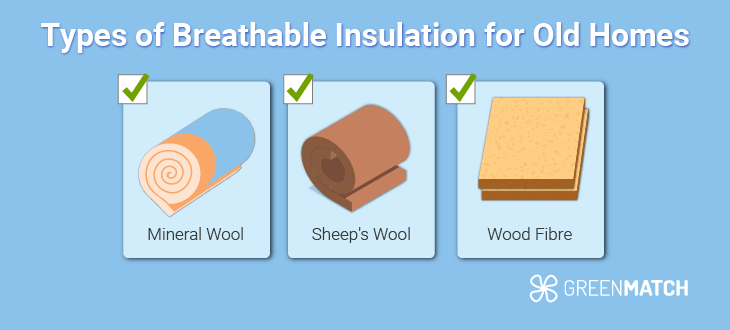
Breathable insulation is particularly important for old homes. This is because old homes tend to have solid walls instead of cavity walls. These are walls made of a single bricklayer with no space in between. As such, solid walls are more prone to moisture buildup and ingress through to the inner wall of your home, needing breathable insulation for solid walls.
Older solid wall homes are also often made from stone, which is historically significant and must retain breathability to properly protect the facade. Breathable insulation for stone walls, like mineral wool and fibreglass, helps regulate temperature and indoor humidity while still preserving the stone facade of the structure and letting the walls breathe.
Several breathable insulation materials make a great fit for older homes:
- Mineral wool: Glass and rock mineral wool is a breathable insulation material found in the form of sheets and blankets. Its popularity, cost-effectiveness and wide availability make it a perfect choice for old homes.
- Sheep's wool: Although more expensive sheep's wool is a high-quality insulator that is similar to mineral wool, but naturally obtained from sheep. This great material is also antimicrobial and entirely recyclable.
- Wood fibre: Made from compressed sawdust, wood fibre insulation boards are a highly sustainable, effective, and breathable material. It's uniquely successful in drying out moisture and reducing condensation.
If you live in a solid wall property or a heritage building, it is highly recommended to consult with a professional installer for the best solution for your home. They will conduct a house assessment and suggest your best approaches for breathable insulation.
Why breathable internal wall insulation matters
Breathable insulation can best be understood as insulation materials that allow for the controlled movement of moisture. They are an incredibly successful long-term solution as they create the opportunity for moisture to dry out and escape.
Not all insulation materials are breathable. Synthetic rigid boards like PIR (polyisocyanurate) and PUR (polyurethane) are very dense and do not allow moisture movement. These types of insulation normally need to be accompanied by a vapour barrier, an extra cost and hassle.
Due to this, adding non-breathable insulation material to the inside walls of your home during internal wall insulation will risk the trapping of moisture within the wall, leading to mould and mildew growth, structural rot, and permanent home damage.
On the other hand, adding breathable insulation will allow for moisture on the inner wall to escape and evaporate, helping regulate indoor humidity, reduce prolonged moisture exposure and keep your home safe and comfortable.
Breathable external wall insulation
In the same sense, breathable insulation for an external wall job is a great way to reduce the risk of moisture ingress and brickwork damage. This is especially important for older homes that have historically significant brickwork or stonework.
Breathable insulation materials like wood fibre insulation boards allow your home to preserve thermal control, moderate moisture, and give your walls the breathability they need to stay healthy and protected.
When using non-breathable insulation, it's important to adequately account for ventilation. Otherwise, you risk accruing moisture buildup on your external walls, potentially causing damage to them and increasing the change of moisture transfer to the inside of your home.
Breathable insulation materials
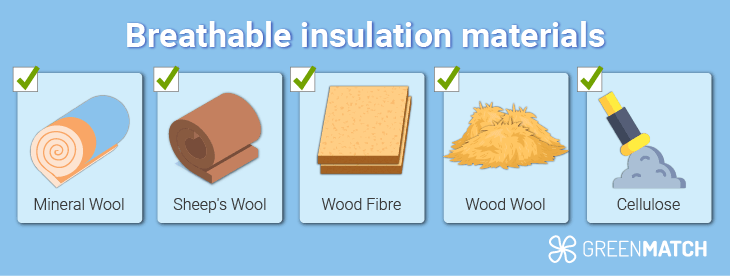
Luckily, there are plenty of breathable insulation material options available on the market, suited for a range of budgets, purposes and applications. Here are some of the most popular breathable insulation materials suited to solid walls, floors, lofts and more:
- Mineral wool: Found made from rock or glass, mineral wool is usually made into blankets and batts and is a very breathable material to work with. Costing around £13 - £17.5, they are also relatively sustainable in production and recyclable.
- Sheep's wool: Sheep wool may cost a higher £17.5 - £22 per m2, but for good reason. Boasting some of the most impressive thermal properties of breathable insulation materials, treated sheep wool is also all-natural, sustainable and entirely recyclable.
- Wood fibre: Made from waste sawdust and wood products, wood fibre insulation boards are a highly sustainable, effective, and breathable insulation board to work with. Using the ability of wood to wick and transfer moisture, they can successfully dry out moisture and reduce condensation. They cost about £12 - £24 per m2 depending on the thickness.
- Wood wool: Made from thin fibres of European spruce wood and bound with other additives such as water repellent, wood wool has an exceptional moisture-regulating capacity, allowing for vapour transfer. It costs around £16.5 - £20 per m2.
- Cellulose: This environmentally friendly loose-fill insulation is made from recycled paper and wood products, making it sustainable and entirely recyclable. It costs around £10 - £12 per m2 and is best suited for underfloors, stud walls, and loft spaces.
On the contrary, several popular insulation materials on the market are not breathable to any extent. They do often exhibit superior thermal insulation but almost always need a vapour barrier to protect against moisture buildup, a significant extra cost.
Here are some of the most common non-breathable insulation materials:
- Spray foam: Normally made from expanding polyurethane, spray foam is an impermeable material that forms an airtight barrier where it forms. It may be moisture resistant, but in turn, has no breathability.
- Rigid insulation boards: Called Celotex and normally made from PIR (polyisocyanurate) or PUR (polyurethane) foam, this rigid insulation may be robust and thermally superior, but is entirely impermeable to moisture. If being used, they require a vapour barrier to keep moisture at bay.
These types of non-breathable insulation materials are particularly unsuitable for older heritage homes, in which the health of the brick facade and home structural integrity can be compromised if there is no adequate ventilation and room for moisture to escape or dry.
What is the most breathable insulation?
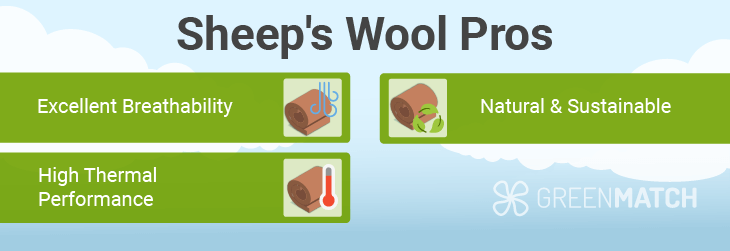
Generally, sheep’s wool is considered to be the best breathable insulation material, coupled with antimicrobial properties, sustainability, and full recyclability, making it a great home insulation solution. It allows for vapour to pass through, preventing condensation buildup and promoting healthier home walls.
But that’s not all! Here are some other perks:
- Excellent breathability: Sheep wool is highly porous and allows for vapour to travel through, reducing condensation buildup in your home and allowing for the insulation to dry out as well. This keeps your home safe and insulation healthy.
- High thermal performance: Sheep wool has an impressive thermal capacity, reaching an R-value range of 3.5 - 4.5 m²K/W, making it one of the most effective insulation materials on the market
- Natural and sustainable: Sheep wool is very sustainable in its production, has hypoallergenic properties, and is even fully recyclable, thus benefitting the planet. Its natural composition also means it does not release harmful toxins into your home.
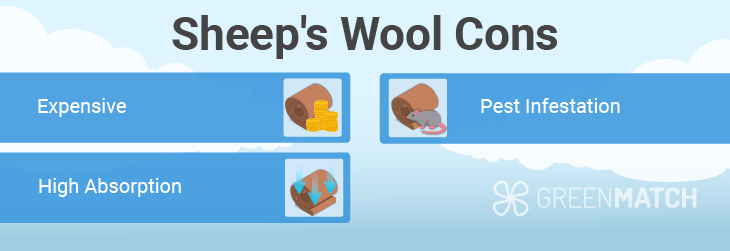
However, like any other insulation material, it’s just as important to address some of the shortcomings associated with sheep's wool insulation:
- Expensive: Sheep’s wool is one of the most expensive insulation materials on the market today, even though for good reason. It generally costs around £17.5 - £22 per m2, compared to around £10 for a m2 of fibreglass.
- High absorption: While the breathable nature of sheep wool makes it great for moisture control, it is unfortunately not immune to water damage. Sheep wool requires adequate ventilation to make sure it does not absorb moisture, leading to insulation damage.
- Pest infestation: Being a natural material with plenty of nesting potential, moths and other similar insects may nest in the material. Not only can this cause an infestation, but these nests and burrows can cause your insulation to clump, leading to cold spots.
The best way to ensure that you make the best decision for your home is to work with a professional installer. Following a house assessment, a professional can suggest the best breathable insulation for you and carry out a job with high workmanship.
Sadly, not everyone has endless hours to spend surfing the web and arranging phone calls to find the best installer. Most prospective customers end up settling for what is easy, missing out on great deals. Luckily, GreenMatch UK can save the day.
By filling out our simple 30-second form, you can receive up to 3 free home-tailored quotes from our nationwide network of trusted installers. The best part? Our services are completely free of charges and obligations. Simply fill out our form and let the bargains come to you. Click the button below to begin!
Fill in the form in just 1 minute
FAQ
Mineral wool insulation – both rock wool and glass wool – are very breathable form of insulation. They allow for vapour to travel through and dissipate, keeping your walls, floors and loft spaces dry and moisture-regulated.
Generally, insulation should be breathable, especially if you live in an older home. This allows you to keep your home’s structural integrity safe, protecting walls, floors, joists and rafters from mould, rot and structural damage. If using non-breathable insulation materials, a vapour layer is important to reduce the risk of condensation buildup.
The most breathable insulation material is likely sheep’s wool, also boasting great anti-microbial properties, sustainable production and full recyclability.
Celotex insulation boards are manufactured from polyisocyanurate, a dense synthetic polymer that is not breathable. Celotex insulation boards would require an adequate vapour barrier to reduce the risk of moisture and condensation buildup.

Akif is a copywriter at GreenMatch since 2023. With a keen interest in community sustainability, green solutions and the role of digital media in identifying climate trends, he aims to hone in on his background in International Studies and Digital Media to provide a multidisciplinary approach to written content rooted in credible research and accuracy.
We strive to connect our customers with the right product and supplier. Would you like to be part of GreenMatch?

